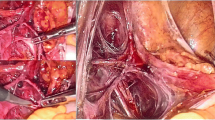Abstract
To evaluate the effects of bethanechol and cisapride on urodynamic parameters in patients undergoing radical hysterectomy for cervical cancer. In this double-blind, placebo-controlled study, 79 patients with cervical cancer were randomized to receive bethanechol (30 mg/day), cisapride (30 mg/day), bethanechol combined with cisapride (same doses) and placebo. Urodynamic study was performed, including flowmetry, cystometry, pressure-flow study and urethral pressure profile before radical hysterectomy. Medication was administered postoperatively during 30 days. At the end of this period, urodynamic evaluation was repeated. There was an increase in both the maximum cystometric capacity and bladder capacity at first desire to void in the placebo group compared to the other groups. The rate of detrusor instability was higher in the group that used bethanechol combined with cisapride. Detrusor pressure at maximum flow was significantly higher when cisapride was used. There was a significant increase in postvoid residual volume in the placebo group. In patients undergoing radical hysterectomy, bethanechol and cisapride determined lower cystometric capacity and decreased bladder capacity at first desire to void, a higher maximum flow rate and higher detrusor pressure at maximum flow, with lower postvoid residual volumes. The early use of bethanechol and cisapride after radical hysterectomies positively modified urodynamic parameters, determining a more efficient detrusor function.
Similar content being viewed by others

References
Larson DM, Malone JM, Copeland LJ, Gershenson DM, Kline RC, Stringer CA (1987) Ureteral assessment after radical hysterectomy. Obstet Gynecol 64: 612–616
Low JA, Mauger GM, Carmichael JA (1981) The effect of Wertheim hysterectomy upon bladder and urethral function. Am J Obstet Gynecol 139:826–834
Carenza L, Nobili F, Giacobini S (1982) Voiding disorders after radical hysterectomy. Gynecol Oncol 13:213–219
Vervest HAM, Barents JW, Haspels AA, Debruyne M (1989) Radical hysterectomy and the function of the lower urinary tract. Acta Obstet Gynecol Scand 68:331–340
Sonda LP, Gershon C, Diokno AC, Lapides J (1979) Further observations on the cystometric and uroflowmetric effects of bethanechol chloride on the human bladder. J Urol 122:775–777
Wein AJ, Malloy TR, Shofer F, Raezer DM (1980) The effects of bethanechol chloride on urodynamic parameters in normal women and in women with significant residual urine volumes. J Urol 124:397–399
Finkbeiner AE (1985) Is bethanechol chloride clinically effective in promoting bladder emptying?. A literature review. J Urol 134:443–449
Carone R, Vercelli D, Bertapelle P (1993) Effects of cisapride on anorectal and vesicourethral function in spinal cord injured patients. Paraplegia 31:125–127
Boyd IW, Rohan AP (1994) Urinary disorders associated with cisapride. Med J Aust 160:579–580
Wyndaele JJ, Kerrebroeck (1995) The effects of 4 weeks treatment with cisapride on cystometric parameters in spinal cord injury patients. A double-blind, placebo controlled study. Paraplegia 33:625–627
Tonini M, Messori E, Franceschetti GP, Rizzi CA, Castoldi AF, Coccini T, Candura SM (1994) Characterization of the 5-HT receptor potentiating neuromuscular cholinergic transmission in strips of human isolated detrusor muscle. Br J Pharmacol 113:1–2
Piver MS, Rutledge F, Smith JP (1974) Five classes of extended hysterectomy for women with cervical cancer. Obstet Gynecol 44:265–272
Abrams P, Cardozo L, Fall M, Griffiths D, Rosier P, Ulmsten U, Kerrebroeck PV, Victor A, Wein A (2003) The standardization of terminology in lower urinary tract function: Report from the standardisation sub-committee of the international continence society. Urology 61:37–49
Hirotsu I, Hayano C, Tani T (1998) Effect of muscarinic agonista on overflow incontinence induced by bilateral pelvic nerve transection in rats. Jpn J Pharmacol 76:109–111
Chen GD, Lin, LY, Wang PH, Lee HS (2002) Urinary tract dysfunction after radical hysterectomy for cervical cancer. Gynecol Oncol 85:292–297
Forney JP (1980) The effect of radical hysterectomy on bladder physiology. Am J Obstet Gynecol 138:374–382
Scotti RJ, Bergman A, Bhatia NN, Ostergard DR (1986) Urodynamic changes in urethrovesical function after radical hysterectomy. Obstet Gynecol 68:111–119
Ralph G, Winter R, Michelistsch L, Tamussino K (1991) Radicality of the parametrial resection and dysfunction of the lower urinary tract after radical hysterectomy. Eur J Gynecol Oncol 12:27–30
Woodside JR, McGuire EJ (1982) Detrusor hypertonicity as a late complication of a Wertheim hysterectomy. J Urol 127:1143–1145
Lin HH, Sheu BC, Lo MC, Huang SC (1998) Abnormal urodynamic findings after radical hysterectomy or pelvic irradiation for cervical cancer. Int J Gynecol Obstet 63:169–174
Roman-Lopez JJ, Barclay DL (1972) Bladder dysfunction following Schauta hysterectomy. Am J Obstet Gynecol 115:81–90
Roberts JM, Homesley HD (1978) Observations on bladder function following radical hysterectomy using carbon dioxide cystometry. Surg Gynecol Obstet 147:558–560
Steele AC, Walsh P, Bentley M, Neff J, Karram M (2001) A randomized, double-blind placebo-controlled trial of the effects of the 5-hydroxytriptamine(4) agonist cisapride on the female urinary bladder. Am J Obstet Gynecol 185:62–64
Kemp B, Kitschke HJ, Goetz M, Heyl W (1997) Prophylaxis and treatment of bladder dysfunction after Wertheim-Meigs operation: the positive effect of early postoperative detrusor stimulation using the cholinergic drug betanechol chloride. Int Urogynecol J 8:138–141
Author information
Authors and Affiliations
Corresponding author
Rights and permissions
About this article
Cite this article
Madeiro, A.P., Rufino, A.C., Sartori, M.G.F. et al. The effects of bethanechol and cisapride on urodynamic parameters in patients undergoing radical hysterectomy for cervical cancer. A randomized, double-blind, placebo-controlled study. Int Urogynecol J 17, 248–252 (2006). https://doi.org/10.1007/s00192-005-1318-1
Received:
Accepted:
Published:
Issue Date:
DOI: https://doi.org/10.1007/s00192-005-1318-1



